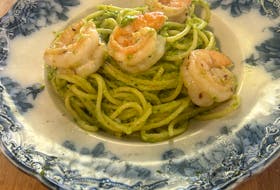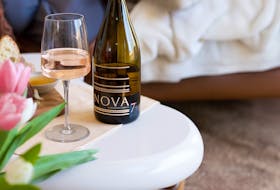Ramen is one of the foods that Kimiko Veinot misses the most from home.
Veinot moved from Shizuoka City, Japan, to New Minas, N.S. 10 years ago. She and her sons, aged 15 and 11, love ramen and eat it whenever they go back to Japan for visits.
For many Japanese people, ramen is a very common snack to have after going out for drinks in the evening, similar to how some people stop for a piece of pizza here, says Veinot.
It's also a quick meal, so people will stop in for a quick lunch during a busy workday. People of all ages can eat ramen, she says, calling it an "ultimate comfort food" for many Japanese people.
And it’s becoming increasingly popular in Canada, as well.

Types of ramen
According to Yoshihisa Takashima, a Kagoshima, Japan native and ramen specialist at Hojo's Japanese Cuisine in Charlottetown, P.E.I., Japanese ramen was brought from China about 110 years ago.
Japan has since made the food its own, using a different manufacturing method that gives it a unique taste and texture from other noodles used in China and other Asian countries, he says.
In fact, each region in Japan has developed its own unique way of making the dish.
For example, Takashima says his area in Kagoshima makes tonkatsu ramen (with a breaded pork cutlet). When he studied in Tokyo, they used a chicken-based soya sauce or miso-based (fermented soybean paste) ramen. Veinot’s region, meanwhile, uses a soya sauce-based ramen.
Now, Takashima says, vegan ramen is booming in Japan. When he lived and studied in Kyoto, Japan, Takashima trained at a vegan-based restaurant, which allowed him to bring this recipe to Canada.

How to eat ramen
There is a proper way to eat a bowl of ramen. People usually eat their ramen with chopsticks, says Veinot, then slurp the noodles. The main reason people slurp is to cool the noodles down before they enter the mouth, she explains.
Next, drink the broth from the bowl. It is not OK to slurp the soup, she adds.
Before you finish the broth, it’s also customary to add extra noodles. If you are still hungry after your first bowl, just add new boiled noodles to your broth, explains Tomoko Sasaki Craig, of Summerside, P.E.I., who originally hails from Kitakyush, Japan, in the same region as Takashima, where tonkotsu ramen is the specialty.
Alternatively, Craig says, you can finish up your leftover ramen broth by adding rice. After finishing the noodles, and while you still have delicious soup left in the bowl, she says to just add plain white rice to the bowl. Add some green onions and red pickled ginger on top for some extra flavour, she recommends.

Instant noodles
Instant noodles and cup noodles are also Japanese national dishes - they were invented in Japan and are often eaten at home, says Takashima. Although Japanese instant noodles and cup ramen are evolving steadily, the ramen you eat at a restaurant and instant noodles are very different, he says.
Instant noodle broth is based on MSG, and the noodles are fried, so they can be mass-produced at a low cost.
“I think instant noodles are still a poor substitute for authentic ramen from a ramen shop,” says Veinot.
Her favourite instant noodles in Canada are the Sapporo Ichiban Shio Ramen packs, available locally in some Atlantic Superstores, but she says they are nothing like the real thing.
Making from home

Because ramen shops are so common in Japan and it is a very reasonably priced food, Veinot says most people don't ever learn how to make it at home. They simply go to a shop to eat it.
To try it at home, however, start with finding ramen noodles, usually available from select larger grocery store chains.
Craig says it’s hard to find authentic Japanese ramen noodles in Atlantic Canada, however, so she ends up ordering them straight from Japan.
Making them from scratch, she says, is a difficult science because you need to know which kind of flour to use and the correct and proportion of ingredients.
Next comes the broth. To make it easier, there are packages of ramen broth available in some grocery stores - Atlantic Superstore, for example, sells pre-made broth you can add your ingredients to, says Veinot - which might get you closer to the real thing.
It's also possible to make ramen broth at home that does not involve having to buy ingredients at an Asian grocery mart. Marc Hetu, a Greenwood, N.S. native, now living and teaching in Kure, Japan, offers a few suggestions based on some ideas from Japanese teachers with whom he works.
"Try using onion soup as a base and adding some soy sauce to it, or alternatively, use stock made from chicken Oxo cubes. Mirin, a rice-based cooking wine, is a great ingredient for adding some sweetness, but a touch of sugar can also suffice," he says.
Craig suggests saving a good pork bone or chicken bone, leftover from a roast, and then cooking it in a big pot for two days as the foundation for your broth.
At Hojo’s, Takashima says they make broth using a traditional style with water, fresh pork or chicken meat, fresh pork or chicken bones, and their special house blend of spices.
“It is a long process for us to make our broths, but we take pride in making them as delicious and authentic as possible,” he says, noting their chicken broth stews for three days and the pork broth for two days.
For toppings, Craig recommends pickled ginger, green onion, nori seaweed, roasted seasoned pork, boiled or poached eggs, sesame seeds, or sesame oil. Bacon adds a good flavour, or try garlic, ginger, cabbage, and onion, she says.
East Coast variations

To put a local spin on ramen dishes, Takashima says they make a lobster ramen at the restaurant, while Craig has used oysters.
Bad Bones Ramen restaurant, operated by two Newfoundlanders in St. John’s, N.L., is all about creating an East Coast ramen style, which co-owner Jasmine Kean calls "authentic but not traditional."
They use real, fresh ingredients and make their own broths, but they are not Japanese and don’t want to appropriate the culture in any way, she says.
When they opened their doors four years ago, ramen was gaining popularity and, at the time, no one in the city was offering it. So, their classically trained chef experimented with flavours to use traditional Japanese ingredients and methods to make their own ramen version.
"We use local ingredients and perhaps more fresh vegetables than you’d typically find in traditional ramen," she says.
“The simplest way to put it is that we have a chef who is used to fine dining and has transferred it to making ramen. It’s like eating a three-course meal from a bowl."
Japanese customers say that although Bad Bones Ramen’s dishes are not anything like they are used to eating at home, they still really enjoy the experience.
Ramen’s popularity is not waning, says Kean, and actually seems to still be growing. More restaurants in the city are offering ramen on their menus now, she adds.
Make it at home
Duane Currie, from Wolfville, N.S. has a strong interest in cooking, especially Asian cuisine. He offers the following recipe for making a North American version of ramen, with easily found ingredients.
Step one
Thinly slice half an onion vertically, mince two cloves of garlic, thinly slice one-third of a green pepper, and one green onion.
Step two
Heat 1 Tbsp of low-taste oil (peanut oil is suggested; don't use olive oil) in a pot over medium-low heat, and fry 1 tsp crushed chilis and the garlic for 30 seconds or so. Add the onions and stir-fry another minute. Add 1 Tbsp soy sauce, one sachet beef stock, and about 3/4 cup of water (adjust water if needed to match the amount of stock you use).
Step three
Stir, and bring to a boil over high heat. Once boiling, add your ramen and turn heat to medium. When ramen is half-cooked, add the green peppers and a little pinch of black pepper, and a pinch of sugar.
Step four
When ramen is cooked, add the green onion and 1/8 tsp of sesame oil, stir it in, and immediately remove it from heat and serve. If desired, add a touch of either cooking sherry or oyster sauce to bolster the taste.
This recipe uses the instant, dried wrinkly noodles that you can buy in bulk, or that come in ramen packages with soup mix.
However, if using Japanese ramen, not instant, reduce the water to 2/3 cup (or noticeably less than the dry stock suggests) for the broth.
Cook the ramen separately, putting the cooked ramen in a bowl and pouring the broth over top.








